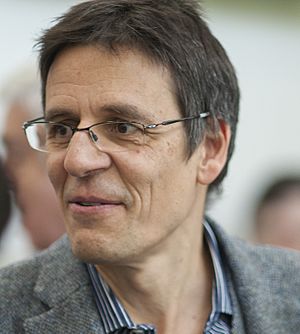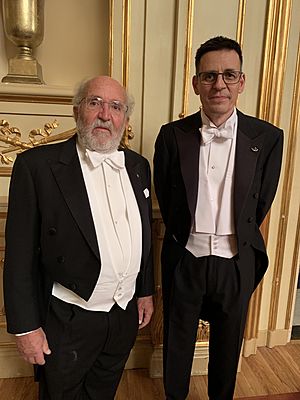Didier Queloz facts for kids
Quick facts for kids
Didier Queloz
|
|
|---|---|

Queloz in 2017
|
|
| Born | 23 February 1966 Switzerland
|
| Nationality | Swiss |
| Education | University of Geneva (MS, DEA, PhD) |
| Known for | First person to find a planet orbiting a Sun-like star outside of the Solar System |
| Awards | Wolf Prize in Physics (2017) Nobel Prize in Physics (2019) |
| Scientific career | |
| Fields | Astronomy |
| Institutions | |
| Thesis | Recherches liées à la spectroscopie par corrélation croisée numérique; (INTER-TACOS: guide de l'utilisateur) (1995) |
| Doctoral advisor | Michel Mayor |
Didier Patrick Queloz is a famous Swiss astronomer. He is known for a huge discovery he made with his supervisor, Michel Mayor, in 1995. They found the very first planet orbiting a star like our Sun, but outside our Solar System! This planet is called 51 Pegasi b. This amazing discovery changed how we look for planets and life in space. For their work, Didier Queloz and Michel Mayor won the 2019 Nobel Prize in Physics.
Didier Queloz is a professor at the University of Cambridge in England. He is also a professor at the University of Geneva in Switzerland. In 2021, he became the first director of a new center at ETH Zurich. This center focuses on how life began and how common it is in the universe.
Contents
Early Life and Education
Didier Queloz was born in Switzerland on February 23, 1966.
He studied at the University of Geneva. He earned his Master of Science degree in physics in 1990. Then, he got a special degree in Astronomy and Astrophysics in 1992. He finished his PhD degree in 1995. His teacher and mentor for his PhD was the Swiss astrophysicist Michel Mayor.
Career and Research
Discovering the First Exoplanet

Didier Queloz helped start a big change in astronomy. While he was working on his PhD, he and his supervisor, Michel Mayor, found the first exoplanet. An exoplanet is a planet that orbits a star outside our Solar System. This discovery was a huge step for understanding planets beyond our own.
In 1995, they announced they had found a giant planet orbiting a star called 51 Pegasi. The planet was named 51 Pegasi b. It was a type of planet called a "Hot Jupiter." This means it is a large, gas giant planet that orbits very close to its star.
They found the planet by measuring tiny, regular changes in the star's movement. This method is called the radial velocity method. It uses the Doppler effect, which is how light or sound waves change as an object moves. They could detect these small changes thanks to a new tool called ELODIE. This tool was a special camera that could measure light very precisely.
For this amazing discovery, they shared half of the 2019 Nobel Prize in Physics. Their work helped us understand how the universe evolved and where Earth fits into the cosmos.
Expanding Exoplanet Research
This first discovery led to a revolution in astronomy. It started the whole field of exoplanet research. For the next 25 years, Didier Queloz focused on improving how we find and study these planets. He wanted to learn about their physical structure. The goal was to understand how they form and change, and how they compare to our own Solar System.
He helped create new tools for astronomy. He also developed new ways to observe planets and new computer programs to find them. He was part of many projects that found hundreds of new planets.
Early in his career, he realized that activity on a star could make it hard to find planets. He wrote an important paper explaining how to tell the difference between a star's own activity and the signal from a planet. His methods are still used today to get very precise measurements of stars.
In 2011, Didier Queloz won the BBVA Foundation Frontiers of Knowledge Award with Michel Mayor. They won for creating new tools and ways to observe planets outside our Solar System.
New Tools and Discoveries
After the ELODIE project, he helped set up an improved tool called CORALIE. This tool was installed on a telescope in Switzerland. It quickly started finding exoplanets around stars in the southern sky.
In 2000, he became a project scientist for HARPS. This was a new type of spectrograph for a telescope in Chile. HARPS started working in 2003. It became a very important tool for precise measurements. HARPS, along with new analysis software, greatly improved how well they could use the Doppler technique. This led to amazing discoveries of smaller exoplanets. These included planets the size of Neptune and "super-Earths."
Studying Transiting Planets
After the first "transiting planet" was found in 1999, Didier Queloz became interested in them. A transiting planet is one that passes in front of its star from our point of view. When this happens, the star's light dims slightly. This allows scientists to measure the planet's size.
In 2000, he used a special method called the Rossiter-McLaughlin effect to study a transiting exoplanet. This method helps scientists understand how a planet's orbit is tilted compared to its star's spin. Ten years later, after improving CORALIE, he worked with a group called WASP in the UK. They found that many planets were surprisingly tilted or even orbiting backward! This gave new clues about how planets form. For this work and all his planet discoveries, he received the Wolf Prize in Physics in 2017.
By combining transiting planet observations with the Doppler method, scientists can measure a planet's mass and size. This helps them figure out its density. The density tells us what the planet is made of. In 2003, Didier Queloz and his team were pioneers in using these methods together. They measured the density of planets found by the OGLE project. They also found the first transiting Neptune-sized planet, Gliese 436 b.
Searching for Earth-like Planets and Life
In 2007, Didier Queloz became an associate professor. His research on combining different observation methods grew even more. He led the follow-up observations for the WASP group and the CoRoT space mission. This work led to over 100 scientific papers. Some of these papers gave new insights into how "Hot Jupiter" planets form. They also found COROT-7b, the first planet with a density similar to a rocky planet like Earth.
His expertise also helped with the Kepler space telescope. He was part of the HARPS-N group that confirmed Kepler-10 had a density like Earth. He also played a key role in designing and setting up a new generation of telescopes called NGTS. This observatory is located in the Atacama Desert in Chile.
When Didier Queloz moved to the University of Cambridge, he focused on finding Earth-like planets. He also wanted to find signs of life in the universe. He helped create the Cambridge Exoplanet Research Centre. This center helps different departments work together on exoplanet research. He also helped organize the first "Exoplanet community meeting" in the UK.
His most recent research involves looking for Earth-like planets around small stars. This work, done with a colleague from the University of Liège, led to the discovery of TRAPPIST-1. This is a planetary system that might be interesting for searching for atmospheres and signs of life. Another successful project was studying the surface or atmosphere of hot, small planets like 55 Cancri e.
He is also part of an international project supported by the Simons Foundation. This project focuses on "Life in the Universe." A key result from this work is defining the minimum conditions needed for the building blocks of life to form on exoplanets.
Didier Queloz's discoveries attract a lot of public attention. He often takes part in documentaries, movies, articles, and interviews. He shares his excitement about science and explains his findings to the public.
In October 2019, Didier Queloz said he believes humans will find life outside Earth in the next 30 years. He said, "I can't believe we are the only living entity in the universe. There are just way too many planets, way too many stars, and the chemistry is universal. The chemistry that led to life has to happen elsewhere. So I am a strong believer that there must be life elsewhere."
In December 2019, Queloz also spoke about climate change. He said, "I think this is just irresponsible, because the stars are so far away I think we should not have any serious hope to escape the Earth... We'd better spend our time and energy trying to fix it."
Awards
- 2011: BBVA Foundation Frontiers of Knowledge Award of Basic Sciences (with Michel Mayor)
- 2013: Clarivate Citation Laureates
- 2017: Wolf Prize in Physics
- 2019: Nobel Prize in Physics
- 2020: Elected Fellow of the Royal Society
Named After Him
- Asteroid 177415 Queloz was named in his honor.
See also
 In Spanish: Didier Queloz para niños
In Spanish: Didier Queloz para niños

